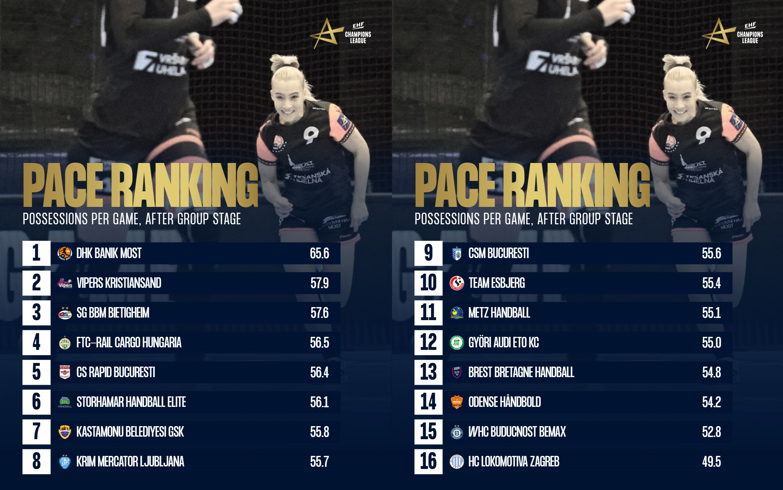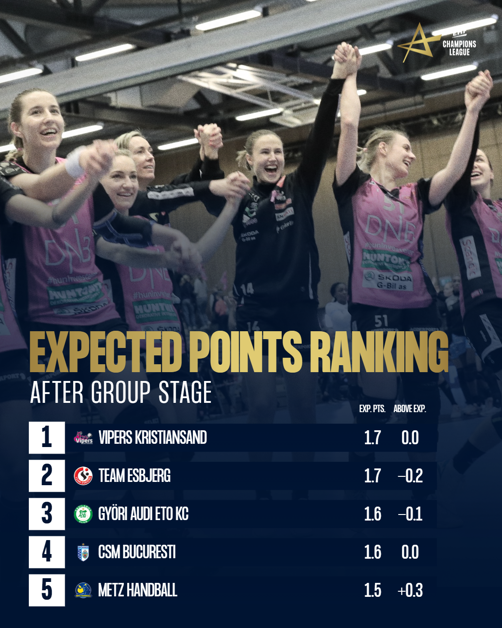In this week’s EHF Champions League Women Match of the Week FTC-Rail Cargo Hungaria face Metz Handball. On first sight, the French side seem to be the odds-on favourite as they finished the group phase as the best team in the entire Champions League with 25 points from 14 matches. FTC, on the other hand, finished fourth in their group with 10 points less than the French.
However, even though they clearly had the best points yield, the goal difference of three other teams was better than Metz’ +77 (or 5.5 per game). Vipers Kristiansand (+83 or 5.9) from group A as well as Team Esbjerg (+88 or 6.3) and Györi Audi ETO KC (+97 or 6.9) had more. FTC's +33 or 2.4 with only one more win than losses is also unusual, but in the other way.
Different pace
How many goals a team scores and concedes depends not only on efficiency but, as has often been mentioned in this column, also on the number of possessions. Of the previously mentioned teams Kristiansand's games were the fastest in the group stage with 57.9 possessions per game. The pace of Metz, Esbjerg and Györ’s games of 55.0 to 55.4 was slightly below the average of 55.9, while FTC was slightly above with 56.4.

It is also very remarkable how these numbers come about. Györ (36.6 seconds), Metz (35.6 secs) and Kristiansand (33.8 secs) are the teams that force their opponents to the longest possessions. But, in turn, all of them have short possessions themselves with Vipers (28.1 secs) and Györ (28.4 secs) leading the ranking and Metz (29.4 secs) being fourth. For Metz’ MOTW opponent FTC it is the other way round. The Hungarians have rather long own possessions (32.9 secs) and rather short possessions by their opponents (30.4 secs).
The overall fastest games have DHK Banik Most with 65.6 possessions on average, while HC Lokomotiva Zagreb are on the other end with 49.5. So, there are really big differences which have effects on the goals shot and conceded. At the same time, this also shows that pace does not correlate with success, as the two teams with the fewest wins are at the top and bottom of the rankings.
Expected points
Adjusted for pace, Györ remain the team with the highest goal difference with 6.4 per 50 possessions. The order for the next teams also remains the same. But the gaps have changed. For example, between Kristiansand and Metz are now closer (+5.0 and +4.9).
The first person to publish the idea of pace-adjusted statistics was the godfather of basketball analytics Dean Oliver in his ground-breaking book Basketball on Paper. Since basketball and handball are quite similar sports in terms of the basic idea, unlike for example baseball or football, many of his principles can also be applied to handball. Another one of these is the calculation of expected wins based on the pace adjusted goal difference.
Since the distribution of goals per 50 possessions per match is (approximately) normally distributed, the so-called Bell Curve Method can be applied. Taking into account the number of goals per 50 possessions in each match played and the variance of these, the expected score of a team with the respective pace adjusted goal difference is calculated.
In fact, the result shows that Metz is the team that overperformed the most. Instead of the expected 1.5 points per game, they had 1.8. The team that underperformed the most was SG BBM Bietigheim. Their results would have expected 1.2 points per game. In fact, however, they had 0.4 points less. Team Esbjerg is also noticeable. The Danes have the second most expected points with 1.7 but rank only sixth in actual points won with 1.4.

Of course, this methodology has some weaknesses. For example, the goal difference does not always show the real difference of strength between two teams. In games where the winner is clear early on, it often happens that they shift down several gears and the losing team comes closer again, which does not reflect the real class difference.
Overperformers vs. underperformers in MOTW
Metz’s quarter-final opponents FTC are another team with fewer points than expected. The Hungarians are the team with the fifth highest difference between expectation and reality. They won 1.1 points per game while 1.2 were expected.
In basketball, the expected points based on the adjusted goal difference have shown to be a much better indicator on the actual strength of a team than the actual points. So, while Metz might be the odds-on favourite against FTC based on their results in the group stage with 1.8 points per game vs. 1.1, the matchup could be much closer as their expected points of 1.5 and 1.2 show.
Of course, many factors such as home court advantage, injuries, or the fact that FTC's preliminary group was considered by many experts to be significantly stronger than that of Metz were not considered in the calculations above. But still, of course, anything short of Emmanuel Mayonnade's team advancing would be a surprise.
Julian Rux is a data analyst. More of his work can be found on his website and blog Handballytics.de as well as on social media: Instagram, Facebook and Twitter.
Photo © Szilvia Micheller








